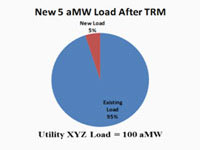Large Industrial Load Analysis
Under BPA’s tiered rate structure, post-2010 load growth is served at market power prices. Power supply required to serve load growth can be purchased from Bonneville, self-supplied from an owned generating resource or purchased from a third party. Regardless of the supplier, the price will most likely be market-based. Future market prices are expected to be nearly twice as high as the price at which Tier 1 loads will be supplied from the federal based system (Bonneville). If a new large industrial load comes on-line or an existing industrial customer’s load increases rolling the incremental purchased power costs into the utility’s revenue requirement may result in unacceptable rate impacts on the PUD’s existing customers.
EES Consulting has assisted several BPA customers develop scenarios that illustrate the rate impacts of various new large load quantities on the utility’s existing retail customers. Bonneville’s customer utilities are asking themselves where the line should be drawn with respect to sharing the incremental costs associated with serving new or expanding large loads with the utility’s other retail customers.
Salem Electric

EES Consulting developed a model designed to educate policy makers on the pros and cons of melding the power supply costs of all future customers. In particular, the model illustrated the impact on retail rates of absorbing the costs of market-priced power that would result from the addition of a new large load. The analysis calculated the retail rate impact on existing customers assuming various wholesale market prices and sizes of new large loads. The analysis also provided analysis regarding rate policies that allow the costs of serving new large loads to be melded into the utilities’ overall revenue requirement and thus the high marginal power supply costs are shared with all customers up to a certain energy level.
Lower Valley Energy
EES Consulting provided Lower Valley Energy’s policy makers with the results of a spreadsheet model that calculated the impact on retail customers of melding the incremental power supply costs associated with serving new large loads. The Board was tasked with implementing new rate policy regarding potential new large loads. The balance between economic development and retail rate stability was included as a key variable in the decision-making process. Several options were presented to the Board that ran the spectrum from passing on all of the incremental power costs to new large loads to melding all of the incremental power costs into the retail rates of Lower Valley’s existing customers. EES Consulting helped guide Lower Valley toward a rate policy that will encourage economic development while minimizing existing retail customers’ exposure to dramatic increases in power supply costs.
